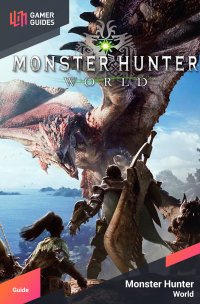The ultimate goal of late game play - besides grinding for various trophies - involves augmenting you equipment, and this part of the game is pretty obscure, in that you won’t know you can even augment arms and armor until you obtain a Warrior’s Feystone (3% drop from Threat Level Two Tempered monsters, 12% drop from Threat Level Three Tempered monsters) or a Hero’s Feystone (3% drop from Threat Level Three Tempered monsters). Once you have one return to the Blacksmith and he’ll admire your prize, before he begins openly dreaming about using it to craft gear for you. This will unlock the “Augment Equipment” option in his menu, which allows you to select a piece of High Rank armor that has reached its maximum upgrade level, or a weapon that is the last in its tree (whether it’s a tier 6, tier 7 or tier 8 weapon is immaterial) and use materials to upgrade them further.
Augmenting armor doesn’t actually require any resources you couldn’t have already obtained, but the materials required will vary a bit depending on the actual item and its quality. Tier 5 - 6 armor will typically require Streamstone Shards and Bird Wyvern Gems, Tier 7 armor typically requires Streamstones and Wyvern Gems, while augmenting Tier 8 armor consumes Gleaming Streamstones and Elder Dragon Bones. Augmenting armor is a one-time expense that requires no real choices to be made, once augmented, armor will have its level cap extended, allowing you to boost that piece further… usually scoring around ten Defense per piece. Aside from the actual materials used in the augmentation process, however, upgrading your armor further will consume hundreds of Armor Sphere points and tens of thousands of Zenny. Selling unneeded monster materials is a fine way to stock up on Zenny, and being diligent about completing bounties during hunts and expeditions should see you obtain plenty of high grade Armor Spheres, although practically anything below an Advanced Armor Sphere is useless at this point.
Weapons are a bit more involved. First, different, specific variants of Warrior’s Streamstones and Hero’s Streamstones are required to upgrade specific weapons. These drop rates are random, so consider the fact that you only have a 1/6 chance of getting the Streamstone you want/need for any weapon every time one does drop. This takes the effective drop rate down to 2% for Warrior’s Streamstones, and to 0.5% for Hero’s Streamstones (aka, why are you doing this to me, Capcom?).
| Streamstone Type | Weapons Augmented |
|---|---|
| Axe | Charge Blade / Switch Axe |
| Blade | Dual Blades / Sword and Shield |
| Hammer | Hammer / Hunting Horn |
| Lance | Gunlance / Lance |
| Ranged | Heavy Bowgun / Light Bowgun |
| Shaft | Bow / Insect Glaive |
| Sword | Great Sword / Long Sword |
As a further complication, depending on the weapon’s tier, it’ll require different materials, and can be upgraded a different number of times. In addition to other materials, Tier 6 - 7 weapons require Warrior’s Streamstones to upgrade, while Tier 8 weapons require Hero’s Streamstones. Tier 6 weapons can be upgraded three times, Tier 7 weapons can be upgraded twice, and Tier 8 weapons can only be upgraded once. While augmenting and upgrading armor is relatively simple - spend materials, unlock more levels, increase Defense as per normal - weapons present you with a choice of options:
| Augmentation | Effect |
|---|---|
| Attack Increase | +5 Attack (displayed attack value varies by weapon type) |
| Affinity Increase | +10% Affinity |
| Defense Increase | +10 Defense |
| Slot Upgrade | Extra Level One Jewel Slot |
| Health Regen | Leeches HP |
With these upgrades, it may be possible for some Tier 6 - 7 weapons to outshine Tier 8 weapons, and it certainly means you shouldn’t let the upgrade level of the weapon be the final word on its quality. The actual augment you’ll want to apply varies by weapon, but the Defense boost is almost always trivial, at best, while extra decoration slots might be nice, but in the long-term a few more level one slots will give you some resistances or quality-of-life skills. Welcome additions, to be sure, but arguably greater Affinity or Attack should be your go-to augmentations, with Affinity usually being the better pick unless you can reach 100% Affinity through a combination of natural weapon bonuses and skills. The Charge Blade’s Super Amped Element Discharge attacks also don’t land critical hits, making Attack a better choice than Affinity.
In all honesty, grinding Threat Level Two monsters is low-yield, save for Warped Feystones, which they’re ideal for. If you want Warrior’s Streamstones and Hero’s Streamstones, however, you should tackle Hardened Elder Dragons. These things naturally do a great deal of damage, only somewhat mitigated by being able to break the level cap of your armor (or rather, push it back somewhat). The extra Defense will only get you a few percentage points of damage reduction, at best, otherwise you’ll just need to learn their attacks, target their weaknesses, and wear gear that resists their attacks. Getting a good meal and equipping three ranks of the Health Boost skill to boost your HP to 200 can’t hurt, either.
The prime target - if you don’t need materials and don’t mind grinding the same foe over and over again - is Vaal Hazak, as his damage is manageable (especially with the aforementioned defensive considerations) his attacks are predictable, and overall, he’s just not too dynamic of a foe… especially if you have three ranks of Effluvia Resistance. With good Defense (450+) and 150+ HP, Vaal Hazak shouldn’t be able to one-shot you… or probably even two-shot you, making him very survivable.

 Sign up
Sign up

No Comments